Baked Coconut Shrimp
These baked coconut shrimp come out of the oven crispy and delicious, perfect for dipping in the sauce of your choice (might I suggest a sweet chili sauce?)
Not every fried food can be made in the oven, but in the case of these baked coconut shrimp, the results are just as good as the original preparation (and noticeably healthier). While the color isn’t as visibly golden brown as fried shrimp, the crunch is unmistakable (and downright addictive).
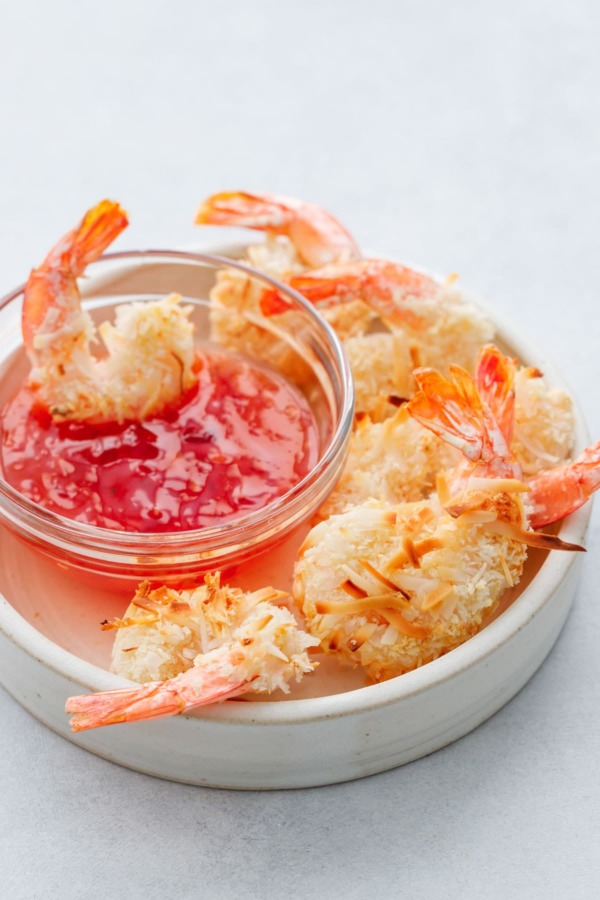
Inspired by some, shall we say lackluster (and that’s putting it kindly) freezer-aisle coconut shrimp that was less than satisfying, we set about making our own oven-fried version that’s just as crispy, and far easier, than its fried counterpart.
Whether you serve them as a crowd-pleasing party appetizer, or eat a whole batch of them yourself for dinner (don’t judge, served with a side of crispy broccolini it’s totally a well-rounded meal), these oven-fried coconut shrimp are sure to become a fast favorite.
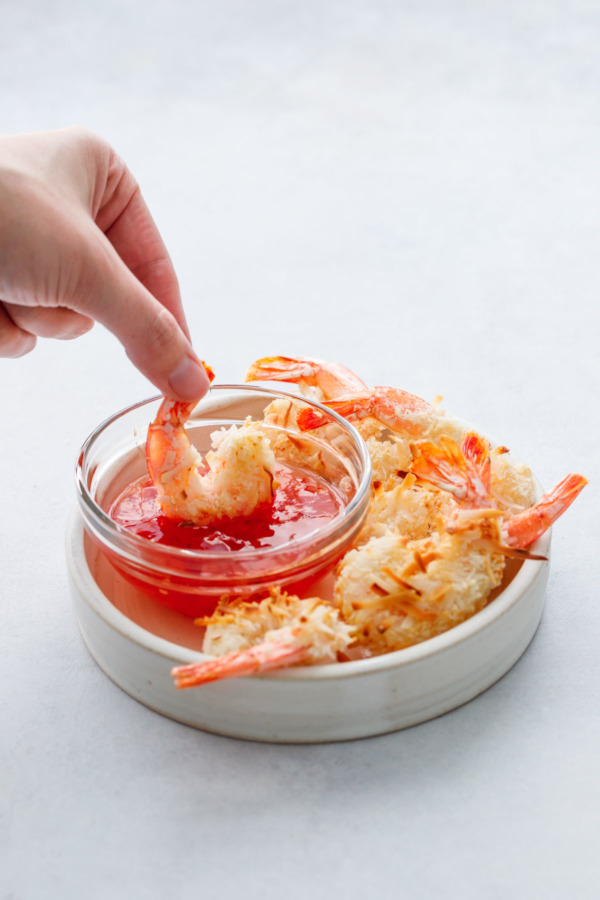
But how do they get so crispy in the oven?!
Well, it’s hard to get that satisfying crunch from coconut alone, so I’ve used a mix of shredded coconut and panko breadcrumbs. The panko ups the crunch factor significantly, no hot oil necessary.
from Love and Olive Oil https://ift.tt/2usV7Fu
Future Fridays: Mohammad Modarres on Interfaith Meat
This Future Friday installment features Mohammad Modarres, founder and CEO of Abe’s Meats, speaking on how he created the first Halal and Kosher meat on the market. One night, while having dinner with friends from different religious backgrounds, he asked himself, “Could you bring the halal and the kosher process together to create one product for everyone?” In this What's the Big Idea talk at the Winter Fancy Food Show, Modarres expalins how he set out to answer that question, consulting with religious leaders and food producers, and eventually created an interfaith meat under his brand, Abe’s Meats.
View Modarres' full talk above as part of SFA's Future Fridays series.
from Food Trends https://ift.tt/2Jqw53Y
Epic Wine Library Collection Grows

The institution known as the greatest wine library in the world is only getting better with age. Recently, two of the most influential wine writers alive today donated their entire collections to UC Davis University Library’s already substantial collection, which focuses on the work of wine writers. Hugh Johnson, author of the World Atlas of Wine, bequeathed his archive of nearly 60 years of wine-book writing, followed by British wine writer Jancis Robinson donating 40 years' worth of papers. In addition, Napa grape grower, winemaker, land preservationist, and philanthropist Warren Winiarski gave the library a $3.3 million gift, which MacKenzie Smith, university librarian and vice provost of digital scholarship at UC Davis, says, “will further build the wine writers' collection and make these works more accessible to researchers and the public.” She adds, “The wine writer collection can be used not only as a lens through which to understand the evolution of wine, but also, as Mr. Winiarski envisions, a resource to improve the very making of wine.”
from Food Trends https://ift.tt/2Obfsba
Product Roundup: Coconut-Based Products: Everyday Indulgences

Coconut’s reign as an alternative to dairy and traditional oils like olive or vegetable is still going strong.
And it’s no wonder why. Providing a sweet, slightly nutty taste, coconut can be used as an ingredient in dishes to add flavor, or as a crunchy, chewy snack all by itself. And the best part? You don’t have to get stranded on a desert island to enjoy it.
Coconut Island Dark Chocolate Coco Bites – Original Recipe. Dark Chocolate Coco Bites are made of moist shredded coconut drenched in rich dark chocolate, topped with toasted coconut. Each sweet bite will transport you to your own personal island getaway. Another one of Coconut Island’s products, Coconut Cashew Crunch with Dark Chocolate Drizzle, was the winner of the 2017 Product of the Year and Best Sweet Snack sofi Awards from the Specialty Food Association. coconutislandsnacks.com
Cornelia Confections Cocomos Toasted Coconut Chips - Orange & Sunflower Seeds. Cornelia Confections’ Cocomos are a coconut chips snack made with all-natural ingredients. As a reflection of Cornelia’s Jamaican roots, she has always had a passion for creating flavor combinations using different herbs and spices. This snack has a light citrus tone, great for orange-lovers, and a slight nutty note of sunflower seeds. With zero corn syrup and trans fats, the brittle is also vegan and gluten-free. corneliaconfections.com
Dewey’s Bakery Moravian Style Toasted Coconut Cookie Thins. This light, indulgent cookie is baked with unprocessed coconuts from the Pacific, with no artificial flavors, colors, or preservatives. Moravian-style cookies are thin and date back to the Colonial American communities of the Moravian Church. Since it was founded in 1930 in North Carolina, Dewey’s Bakery has crafted a delicious baking tradition based on simple ingredients and unique flavors. deweys.com
Fat Badger Bakery Toasted Coconut Cookie. Buttery, chewy, and nutty, Fat Badger Bakery’s Toasted Coconut Cookie is made with no preservatives and all-natural ingredients. Available in packs of 12, the cookies are also vegan, kosher, and Non-GMO Project Verified. In addition to Toasted Coconut, the cookies come in seven flavors and several sampler and gift packs. fatbadgerbakery.com
Green Joy Cinnamon Coconut Superfood Salad Mixer. Cinnamon Coconut Superfood Salad Mixer can be added to salads, yogurt, fruit, and ice cream. Made with ingredients like organic coconut, pumpkin seeds, pecans, and brown sugar, this mixer can even be eaten straight out of the bag. Using only the highest-quality, clean, whole food ingredients, Green Joy’s purpose is to make it exciting to eat your greens. The company uses responsible sourcing to reduce food waste. greenjoylife.com
Leaner Creamer Coconut Oil-Based Coffee Creamer – French Vanilla. Made with coconut oil and other natural herbal supplements like Citrus Aurantium Extract, Hoddie, and Green Tea Extract, which suppress appetite and may promote weight loss, Leaner Creamer is a healthy, guilt-free powdered coffee creamer. The creamer is shelf-stable for one year and balances creaminess and sweetness. It is lactose-free, sugar-free, gluten-free, and kosher certified. leanercreamer.com
LQD Hard Coconut Water. LQD is a collective of brewmasters and curious creators who are inspired by the transformative power of fermentation. LQD products offer a fresh take on an age-old brewing process, transforming simple, quality ingredients into something unexpected. LQD Hard Coconut Water, in Original and Pineapple flavors, begins with coconut water and pure cane sugar that are naturally fermented into alcohol, and blended with fresh coconut water to create a beverage with no artificial flavors, colors, or sweeteners. LQD also offers two Hard Green Tea products in Passion Fruit and Peach flavors. drinklqd.com
Minute Mixology Coconut Mojito Cocktail Mixer. Minute Mixology has reinvented the category with convenient, cocktail mixers offered in single-serve packets. The Coconut Mojito powdered cocktail mixer is made with natural lime, mint, and coconut flavors. Each box contains eight mix packets to be stirred in and enjoyed on the rocks. Low on sugar, this mix is also non-GMO, gluten-free, and kosher certified. minutemixology.com
Rodgers’ Coconut Pudding. Rodgers’ Puddings satisfy sweet cravings with none of the guilt, while also providing a good source or protein and calcium. This Coconut Pudding is available in 4- and 16-ounce sizes. The ready-to-eat pudding is produced with organic, pasture-raised whole milk, pure cane sugar, and coconut flakes. It is Non-GMO Project Verified, kosher certified, and a good source of protein and calcium. When refrigerated, the puddings have a three-month shelf life. rodgerspuddings.com
Weller Original Coconut Bites. Made with coconut, cane sugar, and tapioca, this product is a bite-sized crunchy treat. Each serving contains full-spectrum hemp, which is extracted using a clean process called CO2 extraction, free of solvents like butane. Weller also offers Caramel Coconut Bites, Dark Chocolate Coconut Bites, and several sampler packs. The Boulder, Colorado-based wellness company believes that snacks should be both delicious and functional. With a focus on simple, high-quality ingredients, Weller treats satisfy cravings for feel-good, taste-good food. welleryou.com
Arielle Feger is a content associate with Specialty Food Magazine.
from Food Trends https://ift.tt/2Y6aoJI
Category Education: Honey Hits the Sweet Spot: What Buyers Should Know

Hyperlocal honeys are being sought for a range of benefits.
Consumers are buzzing about honey, and producers can barely keep up with demand for the product that one honey farmer described as “caramelized sunshine.”
Americans consumed about 585 million pounds of honey in 2017, which equates to approximately 1.8 pounds per capita, according to a recent report from the National Honey Board, citing data from the USDA. The total volume consumed increased 50 percent from 2009 to 2017, the research found.
Local honey, in particular, has seen an uptick in demand, as consumers have sought out local products overall and as they have gained a greater understanding of the role that bees play in their local environments. “People increasingly want to support their local community, and bees do a special, magical job in that they help pollinate all kinds of wonderful foods, and then they also produce honey,” says Margaret Lombard, CEO of the NHB, which is based in Longmont, Colo. “They are these perfect little creatures that are great ambassadors for the environment.”
Consumer interest in natural sweeteners as an alternative to processed sugar is also helping drive increased honey consumption, she says. “Local honey products are sort of naturally poised for that food trend,” says Lombard.
Health Benefits
Several health benefits have been ascribed to honey, from its use as a cough suppressant to a sleep aid to a salve for wounds. Advocates of local honey also cite its ability to alleviate some seasonal allergies and its antioxidant properties.
“Made with the same local pollens that adversely impact some, ingesting those same pollens may build natural resistance to the symptoms that make many people uncomfortable during allergy season,” says Andrew Coté, owner of Andrew’s Honey, which has more than 100 beehives in New York City.
Andrew’s Honey sells the products at the Union Square Greenmarket in New York as well as through area supermarkets, restaurants, and bakeries. “Farmers markets are one of the best places to get local honey,” says Coté. “People tend to look for local honey, and the more local the better. People in the know look for their caramelized sunshine via small, local producers.”
Andrew’s is a family business that has maintained beehives since the 1800s. For the past decade-plus, the company has maintained apiaries atop various landmark buildings and other locations all over New York City, including the grounds of the United Nations headquarters. Coté suggests that specialty retailers can maximize their sales of local honey by touting its environmental benefits—it likely has a lower carbon footprint than honey brought in from a greater distance—as well as its efficacy in treating local pollen allergies.
Paul Hekimian, director of HoneyLove, a Los Angeles-based nonprofit conservation organization that seeks to protect the honeybee population through consumer education and by inspiring urban beekeepers, agrees that consumers are seeking out local honey to treat their allergies. Hekimian himself makes small batches of high-end honey, which he provides to a handful of discriminating chefs.
Glen’s Garden Market, Washington, D.C., is among the many retailers that have been building out their local honey portfolio. “We’ve found that folks looking for honey are seeking out two things: raw honeys with proven health benefits and super-local honeys that can be used to mitigate allergies,” says Danielle Vogel, Glen’s founder.
Vogel says that Glen’s, which sources almost all its products from within the Chesapeake Bay Watershed, looks for ultra-local honeys harvested within 20 miles of the store in order to maximize the products’ immunity-boosting properties.
Other Attributes
In addition to seeking out local honeys, consumers have also become more attuned to honey varietals, says Lombard of the NHB. The pollens of specific clovers, for example, or from produce such as blueberries or avocados, can all produce unique honey varietals that obtain their flavors naturally.
“People are increasingly interested in, for example, a buckwheat honey to use in making a barbecue sauce, or perhaps an alfalfa honey or a lavender honey for tea,” says Lombard.
Producers small and large—but mostly small—are jumping into varietals. Specialty food supplier and retailer CP Farms in Paso Robles, Calif., for example, which specializes in producing its own olive oils, lavender, and related products, recently introduced its own Wildflower Honey.
“It is made from nectar collected from our Paso Robles olive and lavender farm, which gives it a natural aroma and flavor,” the company said in a statement. The company’s website also touts the product’s health benefits, and the retention of heathy enzymes that it says would be lost through pasteurization.
Many honey farmers also infuse their honeys with on-trend flavors. Andrew’s Honey, for example, offers several varieties of infused honey, including ginger, sea salt, matcha, turmeric, vanilla, and chili peppers. In fact, hot honey infused with peppers has been trending. The winner of the 2018 Summer Fancy Food Show’s Front Burner Foodservice Pitch Competition was Mike’s Hot Honey, which is made using a hot chili pepper grown in Brazil and wildflower honey from New York.
Lombard of the NHB notes that consumers are also looking for honeys that are organic, raw, or minimally processed. “The biggest trend is this idea that people want to have an ingredient they feel good about, and that they know where it comes from, and they know how it’s produced,” she says. “You don’t need a centrifuge to create honey. You can just open a bee box and see a honeycomb.”
Interestingly, the honeycomb itself has been trending as an interesting component of a cheese tray or a dessert, for example. “We’re seeing a lot of honeycomb being used, which is naturally produced right from the bee and totally edible, and it makes a very beautiful presentation,” says Lombard.
Honey at the Bar
Another growing use for local honeys is in cocktails and spirits. Barry Gambold, general manager of Hotel Indigo-Baton Rouge, in Louisiana, has transformed an area of the hotel’s rooftop to an apiary, which produces honey for use in specialty cocktails at the hotel bar and as gifts for VIP guests. “The product is much better when you get it right out of the hive,” he says.
The hives produce about eight gallons of honey per year, collected in four harvests of about two gallons each. It’s enough for making some specialty cocktails at the bar and for bottling as gifts, but not enough to supply the kitchen, Gambold explains. The gift bottles are packaged with a Hotel Indigo label, and recipients are told that the honey is produced on-site.
The bees obtain some of the pollen to make the honey from the herbs and other plants that are grown in the rooftop garden—including mint, thyme, and peppers—which results in the honey picking up small amounts of flavor from those sources. The bees travel within about a two-mile radius, however, so they are also gathering pollen from other local plants.
Honeys can be incorporated into a variety of cocktails, including the classic “Bee’s Knees,” a Prohibition-era drink that combines gin, honey, and lemon juice. Honey is usually blended with warm water to create a syrup that can be blended easily into cocktails.
“Honey makes a beautiful simple syrup,” says Lombard, who noted that the NHB has done a lot of outreach with mixologists and others to show them how to incorporate local and regional honeys into their cocktail recipes.
Mixed into cocktails, eaten by the spoonful right out of the jar to battle allergies, or incorporated into baked goods or barbecue sauces, honey is becoming an indispensable element of the American diet.
“Folks are eating a lot of honey, and enjoying it,” says Lombard.
Beekeeping: A Labor of Love—and Pain
Harvesting honey, says Barry Gambold, general manager of Hotel Indigo-Baton Rouge, “is a painful thing.”
The hotel installed a rooftop apiary, which supplies honey to the hotel bar and for use as gift bottles for VIP guests. Despite using an automatic device that harvests the honey from the screens, workers “have been stung a few times,” he says.
While protective equipment generally keeps beekeepers insulated from the venom of their honey producers, they also have to endure other hardships. Andrew Coté, owner of Andrew’s Honey in New York, says rooftop honey farming introduces its own set of challenges.
“It is often difficult to find parking, to avoid tickets, to battle traffic, and to carry heavy, bee-filled boxes up and down several flights of stairs,” he says. “The only way to overcome it all is to power through it. Beekeeping requires a strong back and patience—and urban beekeeping more of both.”
It is a labor-intensive business. Labor, in fact, accounts for 50 percent of beekeepers’ costs, according to a recent report from the National Honey Board, prepared by the University of California Agricultural Issues Center.
“These are extremely hard-working folks,” says Margaret Lombard, CEO of the NHB. “It is a real labor of love—there’s nothing glamorous about being a beekeeper. These are dedicated folks who usually come from generations of families who take pride in the products they produce.”
Glossary
More than 300 unique types of honey are available in the United States, each originating from a different floral source, according to the National Honey Board. Honey varies from almost clear in color with a mild taste to dark brown with bold flavor. The color and flavor of each differs by the source of nectar visited by the honey bees.
Here are some of the most common U.S. honey floral varieties.
Alfalfa honey, produced throughout the U.S. Created from the plant’s purple blossoms, light in color with a pleasingly mild flavor and aroma.
Avocado honey, made from California avocado blossoms, is dark in color, with a rich, buttery taste.
Blueberry honey is made in New England and Michigan from the tiny white flowers of the blueberry bush. The honey is light amber in color and has a full, well-rounded flavor.
Buckwheat honey, dark and full-bodied, is produced in Minnesota, New York, Ohio, Pennsylvania, and Wisconsin.
Clover honey has a mild taste with color varying from white to amber depending upon location and type of clover. Clovers are the main contributor to honey production in the U.S.
Eucalyptus honey is produced in California from a diverse group of plants and hybrids. Though it varies greatly in color and flavor, it tends to be a stronger flavored honey with a distinct scent.
Fireweed honey is light in color and comes from a perennial herb that grows in the Northern and Pacific states.
Orange blossom honey is light in color with a mild citrus taste. It is produced in Florida, Southern California, and parts of Texas.
Sage honey, primarily produced in California, is light in color, heavy bodied, and has a mild flavor.
Tupelo honey is produced in northwest Florida. It is usually light golden amber in color with a greenish cast and has a mild taste.
Wildflower honey is a term often used to describe honey from miscellaneous flower sources.
Source: National Honey Board
Mark Hamstra a regular contributor to Specialty Food Magazine.
from Food Trends https://ift.tt/2TV5gZF
Buyers’ Picks: Grab Your Picnic Basket

Spring is the perfect time to grab a friend, some good food and drink, and soak up the sun. Buyers share some of their favorite specialty food recommendations for dining al fresco.
“My favorite go-to for an impromptu picnic meal: all you need is this (Meredith Dairy Marinated Goat) cheese, a baguette, a bottle of bubbly wine, and your preferred salad greens. It’s unlike any other you have ever experienced and completely irresistible.”
—Lydia Burns, Pastoral Artisan Cheese, Bread, & Wine, Chicago
Jenny Rojas Cline, Bi-Rite, San Francisco
- Kookra Krisps
- Massa Organics Organic Whole Almonds
- Olli Salumeria Genoa and Calabrese Sliced Salami
- Pan’s Mushroom Jerky
- Wave Soda
Valerie Neff-Rasmussen, Zingerman’s, Ann Arbor, MI
- Italian Products Classic Tarallini with Extra Virgin Olive Oil
- Raye’s Mustard Down East Schooner Yellow Mustard
- Spring Brook Farm Reading Cheese
- Underground Meats Summer Sausage
- Zingerman’s Bakehouse Brownies
“Picnics are an important part of our business, as both of our markets are located next to iconic parks in San Francisco. And we are always looking for new crackers, salumi, snacks, and beverages to keep people’s baskets fun and interesting.”
—Jenny Rojas Cline, Bi-Rite, San Francisco
Laura Heifetz, Greene Grape Provisions, Brooklyn
- Brooklyn Cured Sweet Soppressata
- Dona Spice Sodas
- Jalapa Jar Salsa
- Matzo Project Salted Matzo Chips
- Roelli Cheese Haus Red Rock Cheese
- Sohha Savory Baba Ghanouj
- Uncle Jerry’s Specials Pretzels
Lydia Burns, Pastoral Artisan Cheese, Bread, & Wine, Chicago
- Aroeira Organic Brazilian Pink Pepper Blossom Honey
- Finca Pascualete La Mini Retorta
- La Quercia Cured Meat Spreads
- Meredith Dairy Marinated Goat Cheese
Matt Caputo, Caputo’s Market & Deli, Salt Lake City, UT
- Caputo’s Mesa Tome
- Divina Cornichons
- Elevation Meats Mexican Mole Salami
- Fossa Chocolate Lychee Rose Dark Milk Chocolate
- Jose Gourmet Trout Paté with Port Wine
- Natur Puglia Taralli Fennel Crackers
Michael Lederman, Joanna’s Marketplace, Miami, FL
- Chukar Cherries Classic Dark Chocolate Dipped Cherries
- Flyer Candy Bars
- Joanna’s Marketplace Tartine Bread
- The Pea Green Boat Cheese Sablés
- Ritrovo Caramiele Natural Honey and Hazelnut Spread
- Ritrovo White Bean Appetizer
“In considering picnic food here in Miami my mind automatically imagines a beach picnic. They are especially nice in the winter here when the temperatures plunge into the mid to low 60s. I would make sure to have a salty appetizer, a main portion of the meal, and something sweet at the end.”
—Michael Lederman, Joanna’s Marketplace, Miami, FL
“This mustard gets its vibrant hue from Californian Cabernet Sauvignon grape must and its unique flavor from whole grain mustard seeds, a dash of vinegar, and warm spices. Use for the ultimate ham sandwich.”
—Asha Loupy, Market Hall Foods, Berkeley, CA
Erin Lynch, Rosemont Market & Bakery, Portland, ME
- Deep River Potato Chips
- Fresh Local Strawberries
- La Spinetta Rosé
- Ritter Sport Chocolate Bars
- Rosemont House Made Focaccia
- San Pellegrino Sparkling Fruit Beverages
Asha Loupy, Market Hall Foods, Berkeley, CA
- Hayden Flour Mills Red Fife Wheat Crackers
- KL Keller Violet Mustard
- Masseria Mirogallo Cruschi Peppers
- Soom Sesame Premium Tahini
Arielle Feger is content associate for Specialty Food Magazine.
from Food Trends https://ift.tt/2Jn7ZXW
Cheese Focus: Cheeses from the Heartland

Midwest cheese producers are bringing something new to the table.
To many Americans, the Heartland is that vast, flat prairie between the coasts with the amber waves of grain. Certainly corn, wheat, and soybeans thrive in the Heartland—also known as the Midwest—but dairying is huge, too, especially in Wisconsin, Minnesota, and Michigan. Artisan cheese from the Midwest barely registers in the region’s economy, but the segment is growing. For merchants, these up-and-coming creameries contribute new flavors and fresh stories to the cheese case. A few Midwest producers, like Capriole Goat Cheese, Hook’s Cheese Co., and Roth Cheese, are veterans that continue to innovate. Many others have yet to complete their first decade.
Retailers who aim to offer a representative sampling of American cheesemaking talent should be sure these gems from the Heartland are part of the rotation.
From Indiana
Capriole Flora: The newest cheese from goat-cheese pioneer Judy Schad is a six-ounce ashed disk inspired by France’s Selles-sur-Cher. A ripe Flora has a wrinkly rind, an oozy layer just underneath (the so-called “cream line”), and a seductive mushroom scent. Julianna, an aged goat tomme cloaked in herbes de Provence, is another gem from this creamery.
Jacobs & Brichford Cheese Ameribella: This farmstead operation makes only raw cow’s milk cheese. A standout in the lineup is the Taleggio-like Ameribella, a semisoft square with a yeasty, garlicky, beefy aroma.
Tulip Tree Creamery Trillium: A triple-cream cow’s milk cheese in a square format, Trillium catches the eye in a cheese case. Under its bloomy rind is a spreadable paste with a faint mushroom scent and the buttery lushness typical of a cream-enriched cheese.
From Iowa
Milton Creamery Flory’s Truckle: The milk comes from the Flory family farm in Missouri, and this clothbound Cheddar spends its first two months there. Then it’s transferred to the cellars at Milton Creamery where it matures for another 10 months. Flory’s has Cheddar-like aromas of melted butter, fresh-mown grass, and toasted nuts but with a fruity pineapple scent as well. It is sweeter and less tangy than the classic English Cheddars, a mellow style that Americans seem to love.
“Another cheese that I recently brought in from Milton is the 4 Alarm Cheddar,” says Lydia Burns, buyer for Pastoral Artisan Cheese, Bread & Wine in Chicago. “It has ghost pepper in it and is definitely on the kickier side, but it’s been really popular, especially in summer with burgers.”
From Minnesota
Alemar Cheese Bent River: This 13-ounce bloomy-rind cow’s milk wheel resembles a large Camembert. When perfectly ripe, it’s dreamy, with aromas of cooked onion, garlic, cabbage, mushroom, and aged beef.
Shepherd’s Way Farms Shepherd’s Hope: This sheep cheese producer makes the excellent Big Woods Blue and a superb natural-rinded aged tomme called Friesago, but Shepherd’s Hope, a four-pound fresh wheel, is its most original creation. Think feta without the brine.
From Michigan
Idyll Farms Idyll Pastures: This farmstead goat producer in Northern Michigan has been amassing awards at the annual American Cheese Society competition. Burns is a fan of the creamery’s fresh goat cheese, Idyll Pastures. Packed in a four-ounce tub and sealed, it has good shelf life, says Burns. Consumers can invert the tub onto a board and present a molded cheese with an embossed surface. The price point is appealing, too, says Burns.
From Missouri
Baetje Farms Miette: The farm was recently sold but Veronica Baetje expects to remain on as cheesemaker, producing the beauties that she originated, like the mixed-milk Miette. Approximately 30 percent sheep’s milk, with goat’s milk making up the rest, the petite bloomy-rind Miette leaves the creamery at about two weeks. Over the next few weeks, it becomes much softer, developing a fragrance of porcini mushroom and the flavor of cheesecake.
Green Dirt Farm Fresh Sheep Cheese: Nothing this creamery makes disappoints. Try the washed-rind sheep’s-milk Bossa and the aged Aux Arcs, a tomme from mixed sheep’s and cow’s milk. But the little tubs of fresh, spreadable, lemony sheep cheese fill a niche at the cheese counter and have impressive shelf life, says C. J. Bienert of the Cheese Shop of Des Moines. “Everyone needs to start eating more of it,” says Bienert. “It’s so fluffy and delicious.” Cross-merchandise with dark bread and smoked salmon.
From Nebraska
Dutch Girl Creamery Rosa Maria: These four-pound farmstead goat wheels are drained in colander-shaped molds, like English Berkswell, and matured for a minimum of four months. The colander produces an eye-catching studded pattern on the natural rind, and the aging yields Garrotxa-type flavor. Cheesemaker Cheruth Van Beuzekom has spent time working with Mary Holbrook, a highly regarded British goat cheese producer. With the aged Rosa Maria, she is helping fill a niche that American goat-cheese makers have largely ignored.
From Wisconsin
Deer Creek Cheese The Blue Jay: This rindless cow’s-milk blue wheel is scented with juniper berries. Ignore the quintuple-crème claim on the label. Triple crème would be more accurate. In any case, the cheese is luscious and the juniper scent does not overwhelm.
Hook Triple Play Extra Innings: Tony and Julie Hook developed Triple Play in 2014, then decided to give a few batches of this three-milk cheese (cow, goat, and sheep) some extra age. Made in 40-pound rindless blocks and matured about 15 months, Extra Innings develops a Gouda-like caramel sweetness, a nutty aroma typical of Swiss alpine wheels and some mellow Cheddar character, too.
Landmark Creamery Anabasque: The two partners behind Landmark specialize in sheep’s milk cheese and the washed-rind Anabasque is their flagship. Modeled after Ossau-Iraty, the aged French Basque tomme, Anabasque smells of caramel and warm butter and has a firm yet creamy texture.
Roelli Cheese Haus Select Cheddar: This new creation from award-winning cheesemaker Chris Roelli is a 20-pound bandage-wrapped Cheddar with a twist. Roelli adds some non-Cheddar cultures to produce nutty, mellow flavors and he tints the interior the color of butterscotch with annatto. “People gravitate to it because of the color,” says Burns, “but then they try it and it’s delicious. It’s a little more fudgy and earthy, not a bitey Cheddar.”
Janet Fletcher writes the email newsletter “Planet Cheese” and is the author of Cheese & Wine and Cheese & Beer.
from Food Trends https://ift.tt/2TXvvPg
Trend Report: Trends from the Winter Fancy Food Show

The Specialty Food Association’s Trendspotter panel covered the recent Winter Fancy Food Show, held in San Francisco, Jan. 13 – 15, to report on new and emerging trends among the 90,000 foods and beverages on display. Among their findings, long-term movements in sustainability, plant-based ingredients, and protein continue to proliferate with new ingredients or expanding categories.
Here are some of the trends from the Winter Show with examples of each. For a full list of the Winter Show trends go to specialtyfood.com/news/wffstrends.
The TRENDSPOTTER Panel
The Winter Fancy Food Show Trendspotters included:
- Polly Adema, PhD, director & associate professor, Master of Arts in Food Studies, University of the Pacific San Francisco Campus
- Reem Assil, chef/owner, Reem’s California, partner, Dyafa
- Andrew Freeman, founder, af&co.
- Lawrence Jacobs, specialty and grocery buyer, Oliver’s Markets
- Kara Nielsen, vice president, Trends & Marketing, CCD Helmsman
- Tu David Phu, chef/owner, AN - a Vietnamese Dining Experience
- Wendy Robinson, buyer, Market Hall Foods
- Melina Romero, manager, Trend Practice, CCD Helmsman
#1 Upcycling and Biodiversity Trends Drive Sustainability Movement
Many companies and products powered by environmental and social concerns were visible throughout the show. More producers are getting serious about product development that addresses food waste, creating upcycled products. Additionally, there is growing awareness about foods made from diverse crops to ensure a variety of crops and animals that makes the food system more resilient and exposes consumers to an assortment of foods and flavors.
Here are some examples identified by the panel:
- Believe in Bambara Beans and Flours, made from bambara, a biodiverse crop
- Render Foods LLC Bryner, vegetable drink upcycled from leftover pickle juice; Weyla, sparkling fruity beverage upcycled from whey
- Renewal Mill Extra Dark Chocolate Chip Cookie, made with okara, a superfood harvested from the pulp of organic soybeans that is created during soymilk production
- Terviva Pongamia, a long-living tree that produces seeds similar to soybeans
- Ugly Juice LLC Good Use Ugly Juice, cold-pressed juice from imperfect fruits and vegetables
- Yolélé Foods Fonio, a biodiverse, gluten-free, ancient African supergrain
#2 Kelp Is the New Ocean-Harvested Star Ingredient
Another driver of sustainability, and intertwined with the plant-based movement, kelp has emerged as the latest sea-based superfood. Examples include:
- Barnacle Foods Kelp Salsa and Kelp Pickles
- Blue Evolution kelp-based pasta and salad
- New Frontier Foods Ocean’s Halo kelp-based superfoods drink
#3 Nut-Based Dairy Expands
Almond and coconut milk are still prevalent among plant-based dairy alternatives, but more varieties are coming to market. Examples include:
- Earth’s Own Food Happy Planet Oat Milk
- Elmhurst Milked Oats Barista
- Kotatsu Cashewmilk Cheese
- Milkadamia Macadamia Buttery Spread and Coffee Creamers
#4 Everything’s Coming Up Roses in Edible Beauty Products
The Trendspotter Panel named Edible Beauty a top trend for 2019, driven by the inclusion of collagen and argan oil in more foods and beverages. At the Winter Show, the latest edible beauty ingredient emerged—rose water or rose petals, noted for their antioxidant and hydrating properties. Examples include:
- Deep Rose Deep Petal Lemonade
- Nielsen-Massey Vanillas, Inc. Rose Water
- Petal Sparkling Botanical Blend beverage
#5 Jerky Revolution Spurs Protein Trend
With the growing popularity of protein-rich diets, plus the plant-based alternative protein phenomenon, this trend isn’t fading anytime soon. Innovation and new applications continue. Examples include:
- Bovino Crispy Beef Jerky
- Maruden Co. Ltd. Cod and Salmon Jerky
- Shima’s Jerky Chips
- True Jerky Jerky Trail Mix
#6 Single Serve and On-the-Go
More producers are emphasizing portions and packaging designed for single servings and convenience. Examples include:
- Lotus Foods Rice Ramen Noodle Soups, individual cups
- Rustic Bakery Pecan Shortbread 3-Pack, snack pack
- Split Nutrition LLC Almond Butter and Strawberry Spread, individual split fast pack
#7 CBD, Fermentation, and Adaptogens Propel the Latest Beverages with Benefits
Often referred to as functional foods, many products at the Winter Show correlated to a variety of health interests: energy and recovery, detoxing, stress relief, gut health, antioxidants. Examples include:
- Buddha Teas CBD Ginger and Turmeric Tea
- Lumen Hemp Elixer, with adaptogenic and Ayurvedic herbs
- New Age Beverages Marley, Marley+CBD Mellow Mood
- Numi Tea, Daily Super Shot, with adaptogenic plants and herbs
- The Republic of Tea SuperAdapt Burnout Blocker Herbal Tea Supplement
- Purely LLC Q-Soo Sparkling Fruit Tonic, fruit-infused drinking vinegar (shrub) and sparkling water
*More states have legalized sales of hemp-derived CBD products. The segment has its challenges as cannabis is still illegal at the federal level.
#8 Plant-Based Extends to Flour Alternatives
The latest expansion in plant-based foods is an array of produce-based flours for baking or blending into smoothies. Examples include:
- AvoLov Avocado Powder
- Kaibae Organic Baobab Fruit Powder
- Hearthy Foods Flours, including apple, banana, spinach, and broccoli
Denise Purcell is editor of Specialty Food Magazine.
from Food Trends https://ift.tt/2ObfkbG
Sourdough Crackers with Olive Oil & Herbs
You’ll never throw away sourdough starter again once you’ve tried these ultra thin and crispy olive oil crackers, seasoned with herbs de Provence and finished with flake sea salt.
These homemade sourdough crackers are the perfect snack all on their own, or, for an extra treat, spread with soft cheese and top with a dollop of homemade jam. They are surprisingly quick, easily prepared while you’re waiting for your bread to rise, though you can also refrigerate the cracker dough for up to 24 hours.
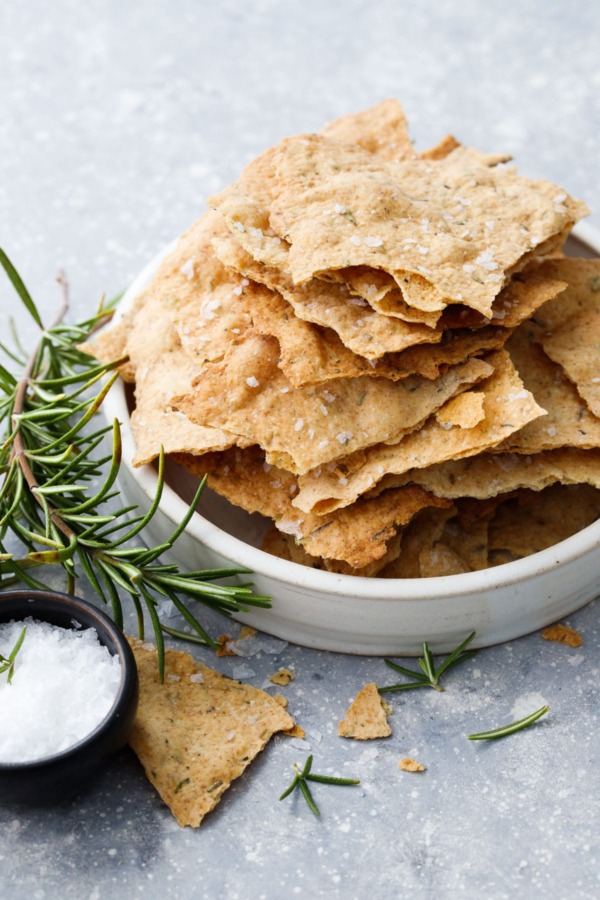
I’ve been making homemade sourdough bread, at least a loaf every other week, for almost a year now. My starter (aka Jane Dough) is a bit of a diva (she prefers King Arthur organic flour and tends to wilt in the heat/humidity of summer) but she’s brought me loads loaves of joy. There are few things as wonderful as homemade sourdough bread.
The one thing that has always bugged me about keeping a sourdough starter, however, is the sheer amount of waste. Every time you feed the darn thing you have to throw away 2/3 of it, and when you’re buying $10/bag organic flour, well, that’s a travesty.
So I set out to find a way to utilize some of that discarded starter.
There are lots of recipes out there, from waffles to pizza crust and beyond, that use sourdough discard. But it was sourdough crackers that grabbed my attention.
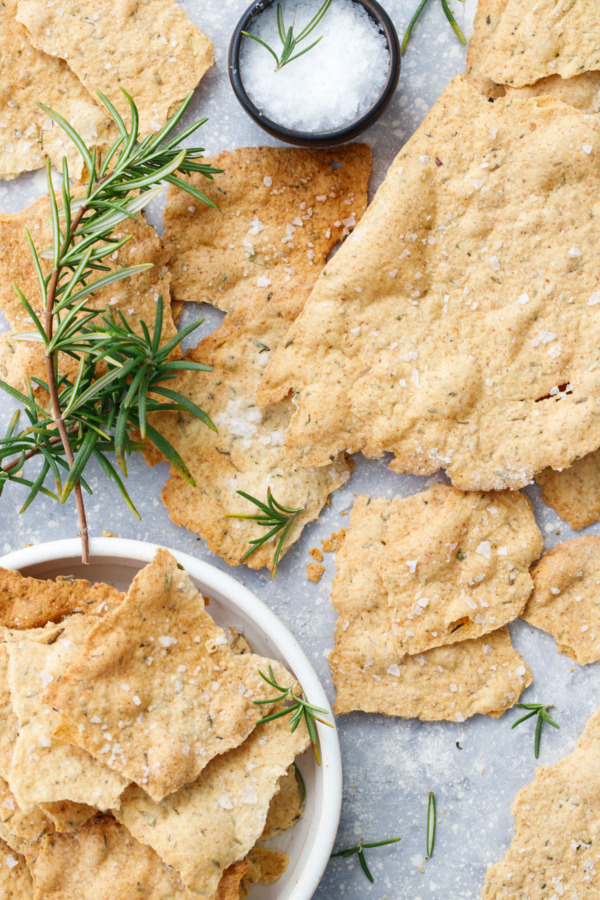
Sourdough crackers require only a few ingredients, the bulk being made up of discarded sourdough starter (the stuff you’d normally toss every time you feed it). That starter is mixed with a bit more flour (I used a combo of all-purpose, whole wheat, and a touch of rye), olive oil, salt and dried herbs. That’s it. It really couldn’t be more simple.
In terms of flavor, they taste a lot like a homemade wheat thin, if wheat thins were made with olive oil and seasoned with Herbs de Provence (fancy wheat thins).
from Love and Olive Oil https://ift.tt/2CnOvMO
Fruit & Vinegar Shrub Mocktails
Non alcoholic drinks don’t have to be boring, as is the case with these fruity vinegar-based mocktails. Play around with different fruits, vinegars, and flavorings to make your own unique concoction!
A shrub is a simple infusion of fruit, vinegar and sugar that, when topped with sparkling soda and other flavors, makes for a unique and interesting refreshment – no alcohol required (although it certainly wouldn’t suffer if you wanted to add some).
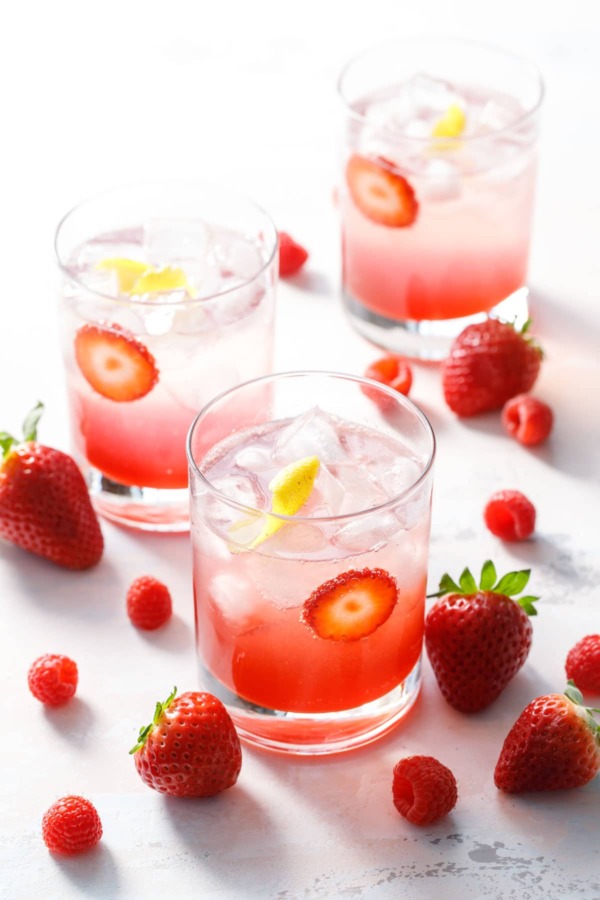
This recipe was created in partnership with Delallo®, our go-to brand for authentic Italian flavor, including pastas, sauces, and specialty imports.
I really love cocktails, or rather, I really love the idea of cocktails. I love the creativity of the flavors, the clever names, the impressive presentations. Unfortunately, my body doesn’t necessarily agree, reacting to the tiniest sip of alcohol as if it were an entire glass.
So most of the time I’m relegated to just a sip of whatever concoction Taylor is enjoying. And maybe a ginger beer if the bar happens to serve it.
Needless to say it makes me really excited when I find a restaurant that actually has a few non-alcoholic mocktails on their menu. Why more bars and restaurants don’t do this is beyond me. Give the DD some love!
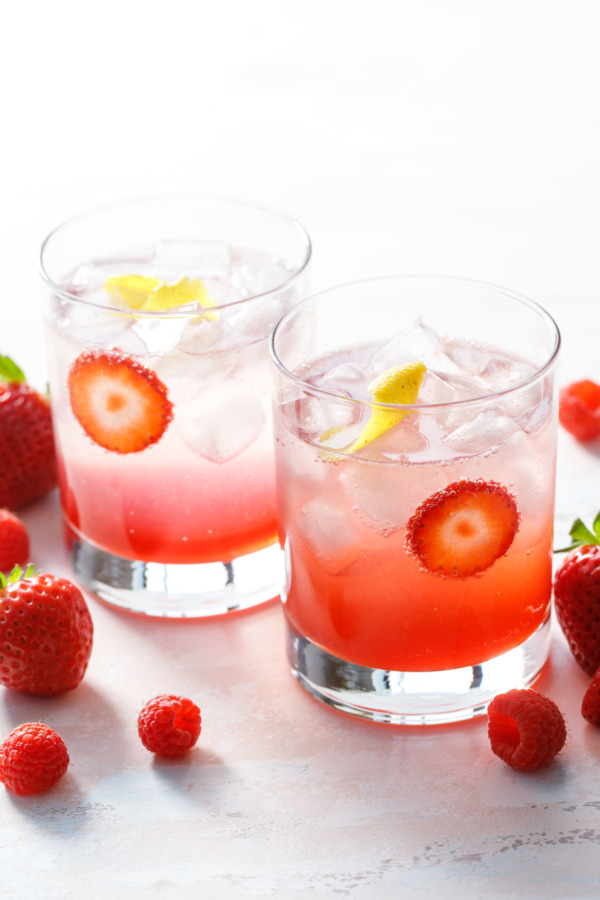
One of my favorite faux-cocktail tricks is the shrub: a fruit and vinegar infusion that gives non-alcoholic beverages much of the same interest and ‘bite’ as their boozy counterparts. Shrubs are great bases for alcoholic cocktails too.
The basic equation for a homemade shrub is fruit + vinegar + sugar. Smash and let macerate for a few days, then strain and enjoy. The finished shrub will keep for months (although I have a feeling it will get used up much sooner). And unlike what you might think, it does not taste like you’re chugging vinegar. The sugar and fruit soften the vinegar’s bite, leaving a candy-like tartness that’s perfect for sipping.
The basic formula is incredibly versatile; you can really use any combination of fruit and vinegar that your heart desires. I used mostly red fruits and berries here, because they were so well matched to the flavor (and color) of Delallo’s Chianti Red Wine Vinegar, but other fruits like peaches, apricots, even pineapples would make lovely shrubs as well.
In addition to mixing up the fruit, you can also play with different vinegars as well. While I used mainly red wine vinegar, I also played with adding a splash of tart and fruity balsamic vinegar, which is absolutely spectacular when paired with strawberries, raspberries or cherries. I found using all balsamic was a little too intense, but a mix of balsamic and red wine was perfect.
Really, as long as the proportions of total fruit to vinegar stay somewhat the same, homemade shrubs are endlessly versatile. While a little sugar is needed, you can increase or decrease it as you like and depending on the natural sweetness of the fruit you are using.
from Love and Olive Oil https://ift.tt/2UCdt1Y
Chocolate Pistachio Cream Thumbprints
If you love pistachio gelato, you’ll love these delightful little cookies, with a rich chocolate shortbread and a center of luxurious pistachio cream.
Thumbprints are one of my all time favorite cookie recipes, and this chocolate pistachio one is no exception; dare I say I love it even more than my go-to jam-filled thumbprints? Chocolate shortbread paired with a creamy pistachio filling takes this old favorite to a whole new level.
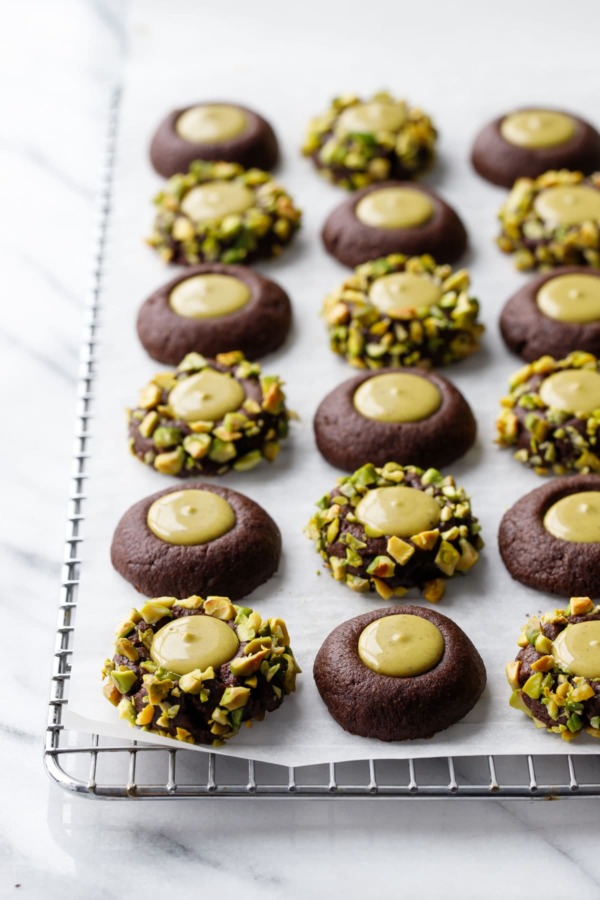
Rewind to last year in Venice when three gelati a day was not an unusual occurrence. But out of all the cups and cones and scoops, the one that stuck out the most was the Manet flavor from SuSo (called that, I assume because it is truly a work of art). With a rich and creamy hazelnut base and a ribbon of salted pistachio gianduja swirled throughout; it was, to put it simply, life changing.
On our last day we all agreed we needed one last scoop (ok, three scoops). As we were waiting in the tiny, unassuming shop, trying to decide which of the many other delicious flavors to round out our cones (because a scoop of Manet was a given), I noticed a small stack of jars on a shelf in the corner. Upon closer inspection I discovered that this was the stuff, the magic pistachio concoction used in the Manet gelato. I immediately grabbed a jar (I paid for it, promise) which I lovingly wrapped in my fluffiest sweatshirt and carted back home with me to the states.
…where it has since sat in the fridge, untouched, for nearly 9 months.
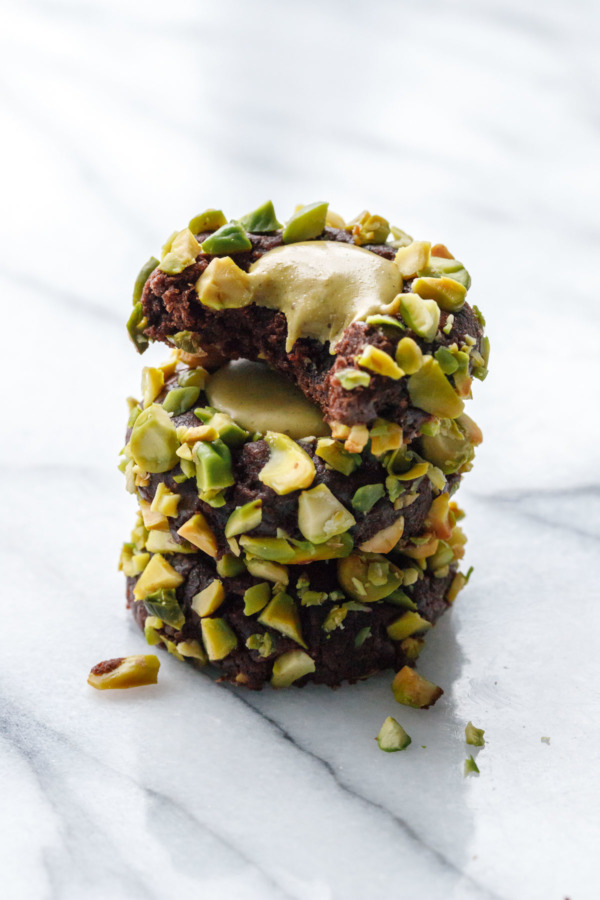
Please tell me I’m not the only one who ‘savors’ special delicacies like this? Hoarding them, not wanting to use them up, until, inevitably, they expire. Whether it be Swiss chocolate or Japanese KitKats or Portuguese sardines, I fully admit it: I’m a hoarder. Such a travesty, and I’m really working hard to fix this fatal flaw about myself, trying not to hoard the goodness I bring home from my travels, but rather enjoy it and not let it go to waste.
So I set about using this little jar of wonder. And when I say little, I do mean miniscule. Far too small to use in a batch of homemade gelato, for instance.
However the idea of a pistachio thumbprint, a chocolate pistachio thumbprint, fluttered through my mind, and once it had, I couldn’t unthink it. It engulfed my thoughts, sending me on a wild internet search for pistachio pastes and creams and butters from all corners of the globe.
I couldn’t rest until this cookie became a reality.
And, oh, what a wonderful reality it is.
from Love and Olive Oil https://ift.tt/2CdnECY
Future Fridays: Andrew Brentano on Cricket Farming
In this edition of the Future Fridays series, Andrew Bretano, co-founder and CEO of Tiny Farms Inc., explains how cricket protein may help save the world. In his What's the Big Idea? talk at the Winter Fancy Food Show, Brentano says, “Eating bugs is not a new idea. People have been eating insects around the world forever." By identifying a sustainable way to farm crickets, Brentano’s company is able to feed countless people for a fraction of the resources needed to raise livestock or agriculture. In addition, farming crickets emits less greenhouse gases as well, helping to reduce our carbon footprint. “There is no guidebook for how to grow crickets. You can’t call up your local agriculture office and ask. But we wanted to create a sustainable solution for everyone, so every farmer can get it up and running.” Though it may be a little gross to some, Brentano notes that the “ick” factor is decreased by turning the crickets into powder, which can then be added to everyday products like chips, sauces, pasta, energy bars, or even pet food.
View Bretano's full What's the Big Idea? talk above as part of SFA's Future Fridays series.
from Food Trends https://ift.tt/2tRXi59
Crispy Oven-Roasted Broccolini
As far as perfect side dishes go, this one checks all the boxes: easy, delicious, crispy and salty—not to mention ready to eat in 15 minutes!
Perhaps one of our all-time favorite vegetable side dishes, this tender broccolini comes out of the oven delightfully crispy. Made with little more than a splash of olive oil, soy sauce, and a sprinkle of flake salt to finish it off, this oven-roasted broccolini makes a great side dish for steak, chicken, or whatever else is on your plate!
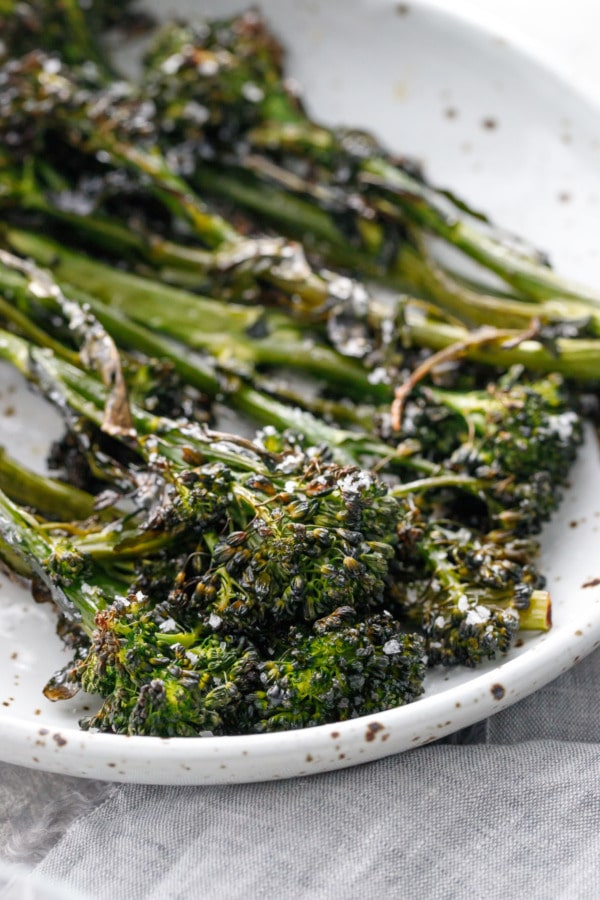
One of our favorite side dishes is simple vegetables roasted with a splash of olive oil and a sprinkle of sea salt. And one of our favorite vegetables to roast in this manner is broccolini.
I mean, it’s almost a non-recipe it’s so easy. That said, some of my previous non-recipes have turned out to be my most popular, so I figure if it’s worth eating, it’s worth sharing here. Maybe you never thought to roast broccolini, or maybe you’ve never even heard of broccolini before. In that respect, this post is a success if only for expanding your culinary horizons.
We often just toss our broccolini with a bit of olive oil, but here I’ve added a splash of soy sauce too for a bit of salt and umami.
Speaking of salt… if you want crispier bits, don’t salt your broccolini before cooking it. The salt will draw water out of the stalk, and any residual water will prevent the broccolini from achieving divine crispiness.
I like to salt my broccolini with coarse flake salt as soon as it comes out of the oven. The slight crunch of the salt a perfect compliment to the crunchy brown bits.
from Love and Olive Oil https://ift.tt/2ToBRHQ
Reverse Sear Steak with Garlic and Thyme
The reverse sear is our favorite method for perfectly-cooked steaks: roasted low and slow in the oven and finished fast in a sizzling hot skillet, the result is tender and juicy steaks that are the perfect shade of pink all the way through.
Rather than searing your steaks first and finishing them in the oven, try the reverse sear method for optimal results every time. Granted, it does take a bit longer overall, but it’s a much more reliable and consistent method, producing tender and juicy steaks perfectly cooked every time.
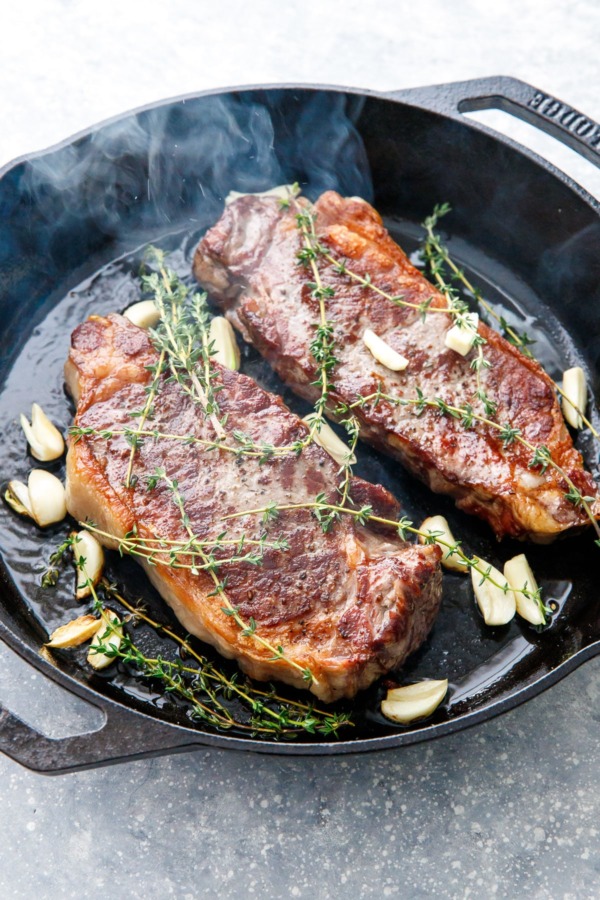
Taylor first started to explore the reverse-sear method when we were researching recipes for our New Year’s prime rib. We had spontaneously picked up a small piece of meat at the market that week, and quickly realized we had no idea how to cook it.
Traditional steak and prime rib recipes have you sear the outside of the steak first in a sizzling hot skillet (which seals in the juices, apparently), and then finish it in a hot oven.
However, we’ve found doing the exact opposite is a better and more reliable way: cook the meat first in a low-temperature oven until it comes up to temperature, and then finish it in a screaming-hot skillet to create that perfect outer crust.
What you end up with is a piece of meat that is perfectly pale pink all the way through—instead of the traditional method where the outer ring is gray and only the inner-most strip is still pink. You’d get similar results cooking with a sous vide (which has a similar principle, bringing the meat up to temperature slowly and evenly).
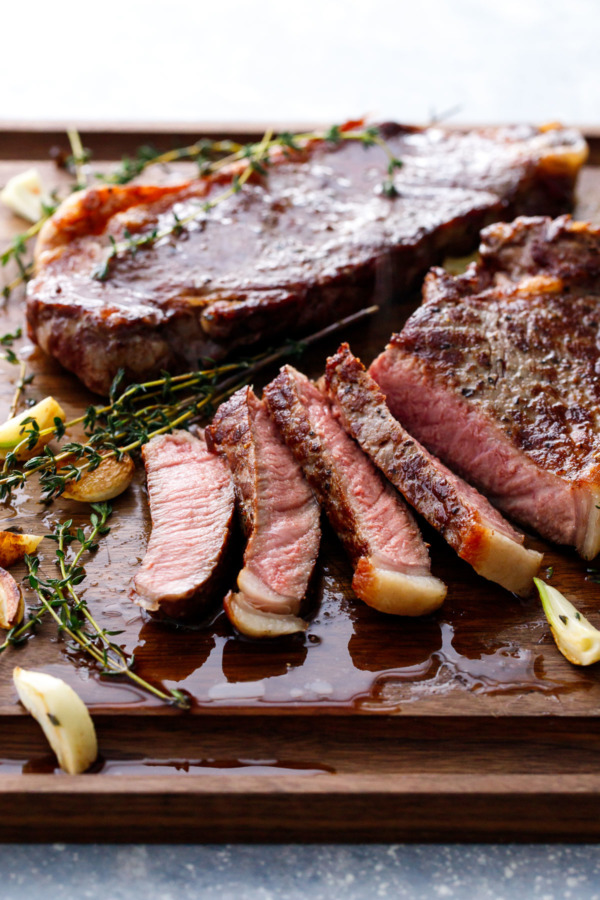
Now, it might take a few tries at this before you find your optimal temperature. The ‘perfect’ temperature for you will probably different than ours, it just depends on how you like your steak.
Traditional guidelines say to cook a steak to 125 degrees F for medium. With the final sear at the end of this process, however, we found that stopping 5-10 degrees short of this to be just right. For us, 115-118 produced a perfect medium. If you like your steaks a bit more medium-rare, 108-110 or so would be ideal.
Cooked in this fashion, a good piece of meat needs little more than a sprinkling of salt and pepper (sound familiar? Our favorite oven-roasted chicken breasts are similar in that regard). We did choose to add some fresh thyme and garlic cloves at the very end, just for a bit of added color and interest.
from Love and Olive Oil https://ift.tt/2GZ4sNg
-
If you’re thinking about visiting Croatia, chances are Plitvice National Park is on your radar (as it should be!) Before you go, here are so...
-
Here’s how to make grilled vegetables! Fire up the grill for the best summer side dish that goes with any meal. It’s grilling season! The...
-
If you love pistachio gelato, you’ll love these delightful little cookies, with a rich chocolate shortbread and a center of luxurious pistac...
Homemade Peppermint Bark (Small Batch)
Peppermint bark is a satisfyingly simple holiday treat, with two gorgeous layers of dark and white chocolates and a flurry of candy cane pie...




